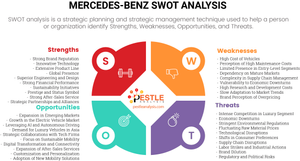Our Mercedes-Benz SWOT Analysis examines 10 Strengths, 9 Weaknesses, 11 Opportunities and 10 Threats of the German car maker.
I think we can all agree easily that Mercedes-Benz is one of the topmost easily recognizable car brands in the world. Enthusiasts and amateurs alike, everyone has a reason for liking the brand, be it its amazing performance or sleek looks. However, to fully appreciate everything the company has going on for them, we can look at this Mercedes-Benz SWOT Analysis.
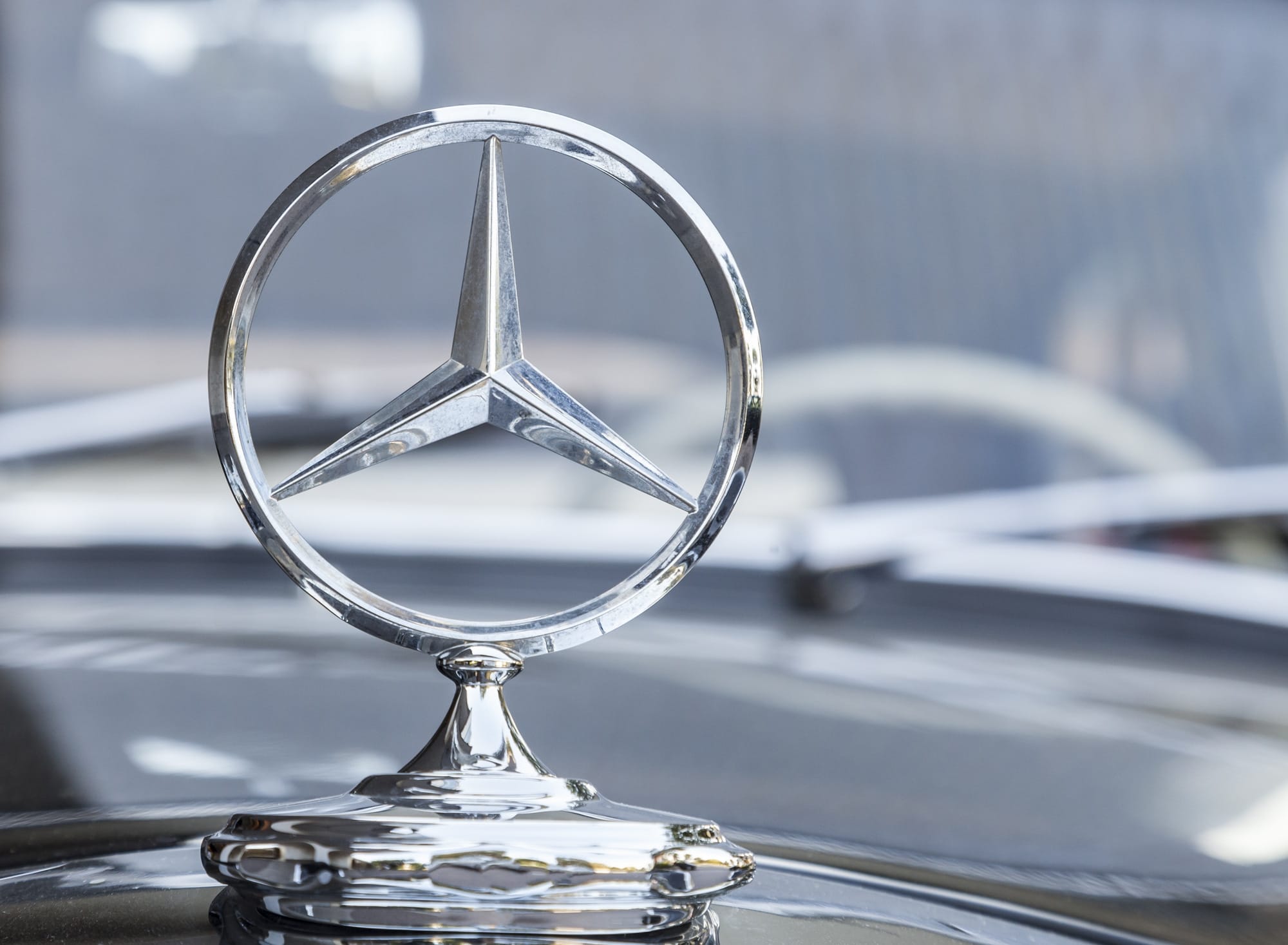
The brand was started in 1926 by merging two individual cars; Daimler-Motoren-Gesellschaft which made Mercedes and German automobile engineer Karl Benz’s Benz patent motor wagon. This means the company has been around for 95 years!
They have their headquarters at Stuttgart, Baden-Württemberg, Germany. As of 2023, the company has proudly been able to sell 2.04 million units of it all around the world. The company specializes in both luxury as well as commercial vehicles.
SWOT Analysis of Mercedes-Benz
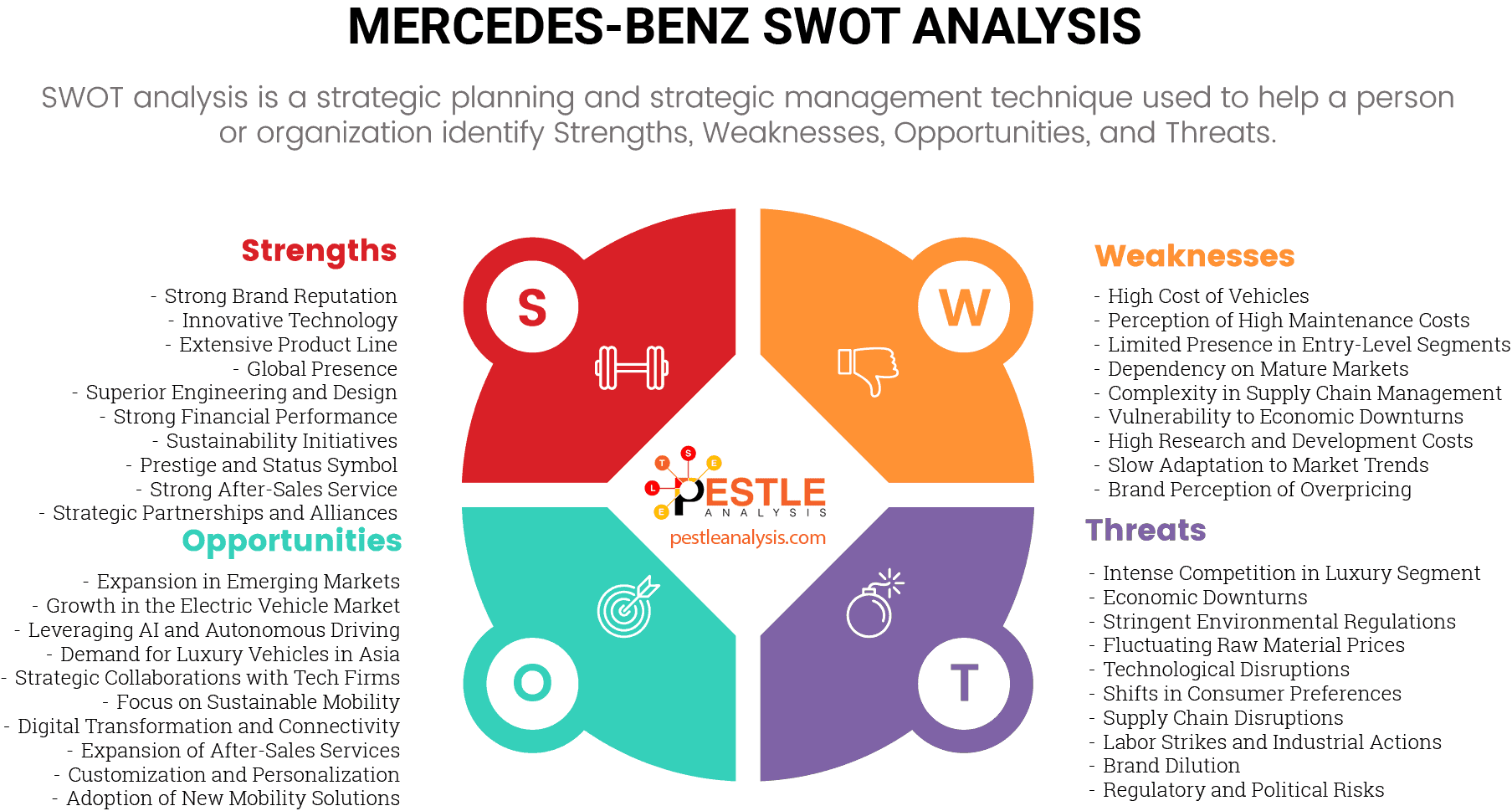
In the following SWOT analysis, we are going to be taking a dive into certain factors and events which shape up the current situation of the company, particularly four key factors. Any factors which lead to prosperity and well-being for the company are its strengths. Consequently, any factors or events which have led to negative outcomes for Mercedes will be classified as its weaknesses.
Any factors which can be explored by Mercedes in the future to the best of its advantage will be the opportunities and any factors which are currently dangerous to the brand’s health will be threats.
Now that we have the factors a bit more defined, before moving on we should also clearly classify them too. The first two factors i.e. strengths and weaknesses are called internal factors whereas the latter two i.e. opportunities and threats are called external factors.
Internal factors have the ability to impact the “inside” of a business and can mostly be easily controlled by the company under consideration. External factors on the other hand are out of anyone’s hands and cannot be controlled. This makes them slightly trickier than the former.
Let’s explain this better with an example. Mercedes having an excellent supply chain for its services is its strength because it is possible by the company’s collective efforts. It is controllable. But people moving on from their vehicles to some other alternatives because of emerging trends would be a threat because the company cannot control people's preferences.
Let’s now see in detail where the brand is standing these days.
Mercedes-Benz’s Strengths
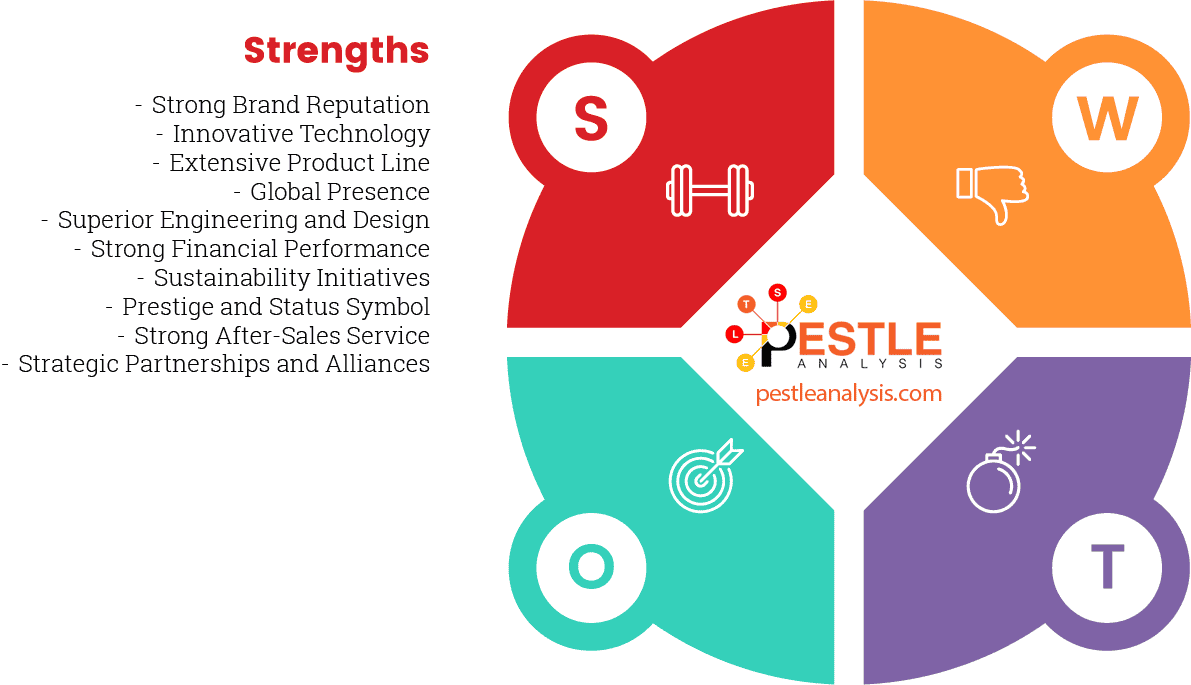
Although we can write a book on why and how Mercedes is a very potent brand, for the sake of convenience here are some of the most prominent strengths the brand boasts.
- Strong Brand Reputation: It does not need much justification that Mercedes-Benz is one of the most powerful and influential brand names of this era. One instantly thinks of this company when thinking about premium luxury cars. Mercedes-Benz is globally recognized for its luxury, quality, and reliability. The brand's longstanding reputation adds significant value and customer loyalty.
- Example: Despite a highly competitive market for luxury electric vehicles, the all-electric EQS SUV quickly became a bestseller in major markets such as the United States, Europe, and China. This success was attributed to the brand's longstanding reputation for quality, innovation, and luxury, which instilled confidence in consumers even before they experienced the new model. The overwhelmingly positive response and high demand for the EQS SUV reinforced Mercedes-Benz’s image as a leader in both luxury and technological advancement in the automotive industry.
- Innovative Technology: Obviously, a brand as big as Mercedes will be expected to prioritize allocating investments to their research and development programs; it should not come as a surprise but they have taken it to the next level. Mercedes-Benz is at the forefront of automotive innovation, integrating advanced technologies such as autonomous driving, AI, and state-of-the-art infotainment systems.
- In 2020, they have opened up a state-of-the-art R&D center in China to further expand their research work to stay ahead in their game. This site in Beijing is an addition to their previous programs, costing 13.5 million EUR. The company invests this huge amount in China because they have accepted that the country is the hub for automotive success.
- Extensive Product Line: The company offers a wide range of vehicles from luxury sedans and SUVs to high-performance sports cars and commercial vehicles, catering to diverse market segments.
- Global Presence: With a strong global distribution network, Mercedes-Benz has a significant presence in key markets across Europe, North America, Asia, and other regions.
- Superior Engineering and Design: Known for its superior engineering, Mercedes-Benz vehicles are often benchmarks in terms of performance, safety, and aesthetics.
- Example: In 2024, the new S-class featured groundbreaking innovations such as an advanced suspension system that adapted to road conditions in real-time, providing an unparalleled smooth ride. Additionally, the interior design showcased state-of-the-art materials and an intuitive infotainment system with an AI-powered user interface. Critics and consumers alike praised the new S-Class for its meticulous attention to detail, exceptional craftsmanship, and cutting-edge technology, solidifying Mercedes-Benz’s reputation for engineering excellence and superior design in the automotive industry.
- Strong Financial Performance: Consistent financial health and profitability enable Mercedes-Benz to invest heavily in research and development, marketing, and expansion strategies. How much do you think the company is worth today? While it is impossible to know the exact amount, there are various estimates that say that the average net worth of Mercedes in 2024 is 90 billion USD! Having these kinds of numbers is perhaps one of the best strengths any business can dream to attain especially when they are as old as Mercedes.
- Sustainability Initiatives: The brand is committed to sustainability, with initiatives focused on electric vehicles, reducing carbon emissions, and increasing the use of recyclable materials in production.
- Prestige and Status Symbol: Owning a Mercedes-Benz is often associated with prestige and success, enhancing the brand's appeal to affluent customers and professionals.
- Strong After-Sales Service: Mercedes-Benz offers excellent after-sales services, including warranties, maintenance plans, and customer support, which contribute to high customer satisfaction.
- Example: The brand introduced the "Mercedes Star Prepaid Maintenance Program." This comprehensive service package included extended warranties, 24/7 roadside assistance, free maintenance for the first five years, and a dedicated customer support hotline with rapid response times. Customers who purchased new vehicles reported high satisfaction levels due to the seamless, worry-free ownership experience. The program also featured a mobile app that allowed owners to schedule service appointments, track vehicle health, and receive instant support. This enhanced after-sales service not only improved customer loyalty but also attracted new buyers, reinforcing Mercedes-Benz's commitment to exceptional customer care.
- Strategic Partnerships and Alliances: The company has strategic partnerships and alliances with technology firms and other automotive manufacturers, enhancing its capabilities and market reach.
Check out our full list of strengths that can affect any business here.
Mercedes-Benz’s Weaknesses
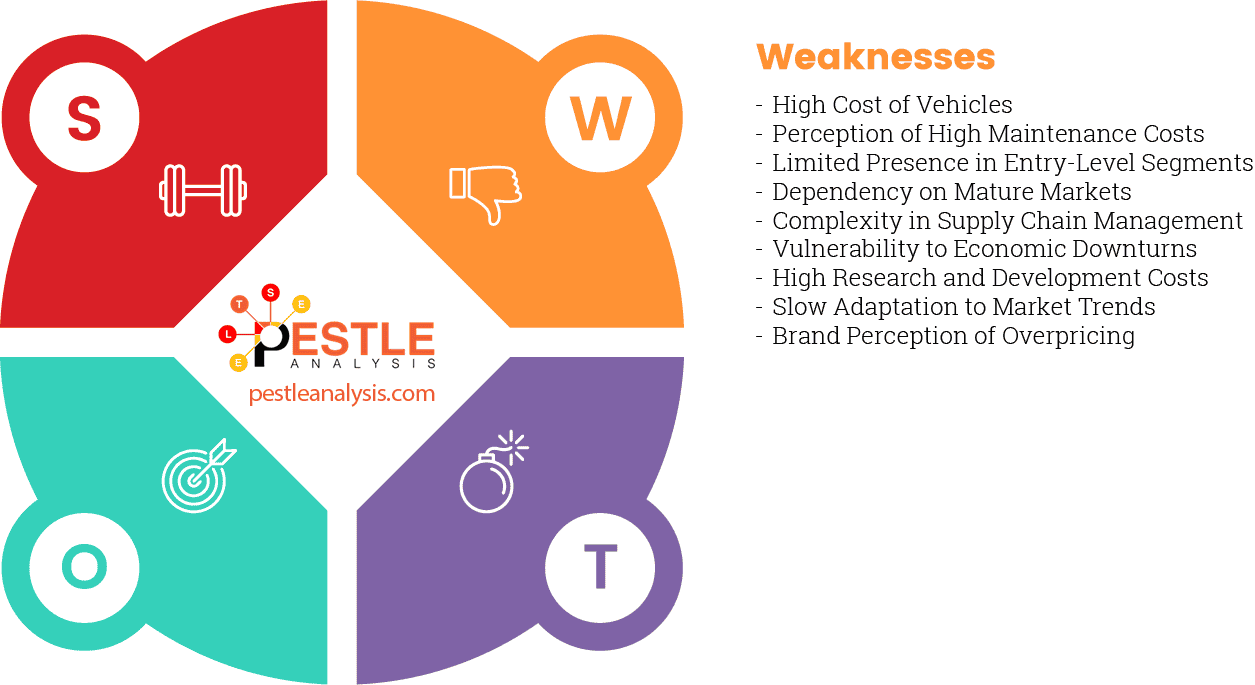
Alas, even Mercedes has certain weaknesses; proof that perfection is merely an ideal concept. Let’s see what the biggest weaknesses of the brand are.
- High Cost of Vehicles: Mercedes-Benz vehicles are priced at a premium, which can limit accessibility to a broader customer base.
- Perception of High Maintenance Costs: The maintenance and repair costs for Mercedes-Benz cars are perceived to be high, potentially deterring some buyers.
- Example: Consumer Reports, which surveyed car owners about their out-of-pocket expenses for maintenance and repairs in 2024, found that German brands, including Mercedes-Benz, were among the most expensive to maintain over a ten-year period. Specifically, the analysis revealed that maintenance and repair costs for Mercedes-Benz vehicles were more than double those of domestic luxury brands like Lincoln. This finding reinforced the long-held perception that owning a Mercedes-Benz involves significant ongoing expenses, which can deter potential buyers who are concerned about long-term ownership costs.
- Limited Presence in Entry-Level Segments: Mercedes-Benz has a relatively limited presence in the entry-level vehicle market, where competitors may offer more affordable options.
- Dependency on Mature Markets: The company heavily relies on sales from mature markets like Europe and North America, making it vulnerable to economic fluctuations in these regions.
- Complexity in Supply Chain Management: Managing a complex global supply chain can lead to challenges in ensuring timely delivery and maintaining quality standards across all markets.
- In 2021, the company decided to recall a total of 1.3 million of its units which were produced during the years 2016-21 because of a defect with their emergency communication module software. This could potentially give people incorrect addresses during emergencies. Although the problem can be fixed easily, the most inconvenient event being a trip to the dealer, they still decided to take the matter into their own hands. Everyone is allowed to make mistakes as long as they are able to fix them. However, brands such as the one we are studying are expected to have nearly zero mistakes.
- Vulnerability to Economic Downturns: Being a luxury brand, Mercedes-Benz is more susceptible to economic downturns, which can significantly impact its sales.
- High Research and Development Costs: The extensive investment required for ongoing innovation and development can strain financial resources, especially in economically challenging times.
- Slow Adaptation to Market Trends: Sometimes, Mercedes-Benz has been slow to adapt to rapidly changing market trends, such as the early adoption of electric vehicles.
- Brand Perception of Overpricing: There is a perception among some consumers that Mercedes-Benz vehicles are overpriced compared to competitors offering similar features and quality.
Explore our comprehensive list of weaknesses that can challenge any business here.
Mercedes-Benz’s Opportunities
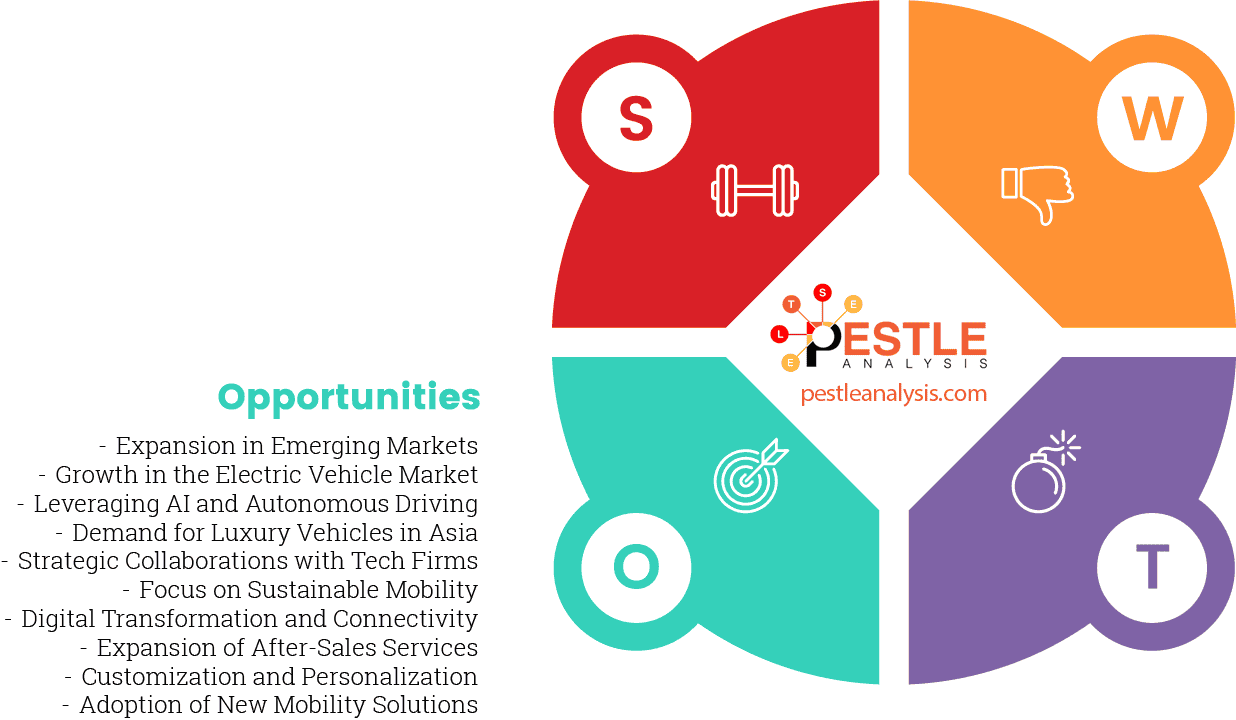
- Expansion in Emerging Markets: By increasing their presence in emerging markets such as China, India, and Brazil, Mercedes-Benz can tap into new customer bases. Strategies include establishing local production facilities, tailoring marketing efforts to local tastes, and offering more affordable models to capture market share. The middle-income class is the largest group of people in almost every country and this segment continues to grow. Mercedes can take advantage of this market and focus on producing alternatives. Yes, they do have some cars which are more economical but they can look into more variety.
- Growth in the Electric Vehicle Market: The increasing demand for electric vehicles (EVs) provides an opportunity for Mercedes-Benz to expand its EV lineup. Investing in research and development for better battery technology, expanding charging infrastructure, and launching new electric models can help capitalize on this growing trend. So far they are very new to this niche but it has a lot of potential for growth because not many car brands have great electric alternatives. Electric cars can also fit with their luxury branding because they are pretty expensive.
- Leveraging AI and Autonomous Driving: Advancements in artificial intelligence and autonomous driving technology can enhance the appeal of Mercedes-Benz vehicles. By developing and integrating cutting-edge autonomous features, Mercedes-Benz can offer safer and more convenient driving experiences, attracting tech-savvy customers.
- Increasing Demand for Luxury Vehicles in Asia: With rising incomes and growing demand for luxury vehicles in Asia, Mercedes-Benz can expand its product offerings and tailor marketing strategies to this region. Launching exclusive models and offering personalized services can attract wealthy Asian consumers.
- Strategic Collaborations with Tech Firms: Partnering with technology companies can help Mercedes-Benz stay at the forefront of automotive innovation. Collaborations can lead to the development of new technologies, such as advanced infotainment systems and connected car features, enhancing the overall driving experience.
- Focus on Sustainable Mobility: With growing environmental concerns, there is a significant opportunity in promoting sustainable mobility solutions. Mercedes-Benz can invest in the development of hybrid and fuel-cell vehicles, implement eco-friendly manufacturing processes, and engage in carbon offset programs to appeal to environmentally conscious consumers.
- Digital Transformation and Connectivity: Embracing digital transformation can improve customer experiences and operational efficiencies. Developing advanced connectivity features, offering over-the-air updates, and enhancing digital sales platforms can attract tech-oriented buyers and streamline operations.
- Expansion of After-Sales Services: Enhancing after-sales services can lead to increased customer satisfaction and loyalty. Mercedes-Benz can expand its maintenance and service packages, offer extended warranties, and implement digital service tracking to provide a superior ownership experience.
- Customization and Personalization: Offering greater customization and personalization options can appeal to luxury car buyers looking for unique vehicles. Mercedes-Benz can expand its bespoke services, allowing customers to tailor their vehicles to their specific preferences in terms of design, features, and performance.
- Adoption of New Mobility Solutions: As urbanization and changing transportation needs evolve, there is an opportunity to explore new mobility solutions such as car-sharing, ride-hailing, and subscription services. Mercedes-Benz can develop and offer these services to cater to the changing preferences of urban consumers, providing flexible and convenient transportation options.
- Alliances: Mercedes is a pretty stable brand on its own but a little help never hurts anyone. They can look into the possibility of forming alliances with other car companies to gain a bigger chunk of the market and to reduce some risks. Nissan has an alliance with Renault and this partnership has been a blessing in disguise for both of them during many bumps in their journey towards success. Sometimes you need help in achieving things that wouldn’t be possible solo.
Discover our detailed list of opportunities that any business can leverage for growth here.
Mercedes-Benz’s Threats
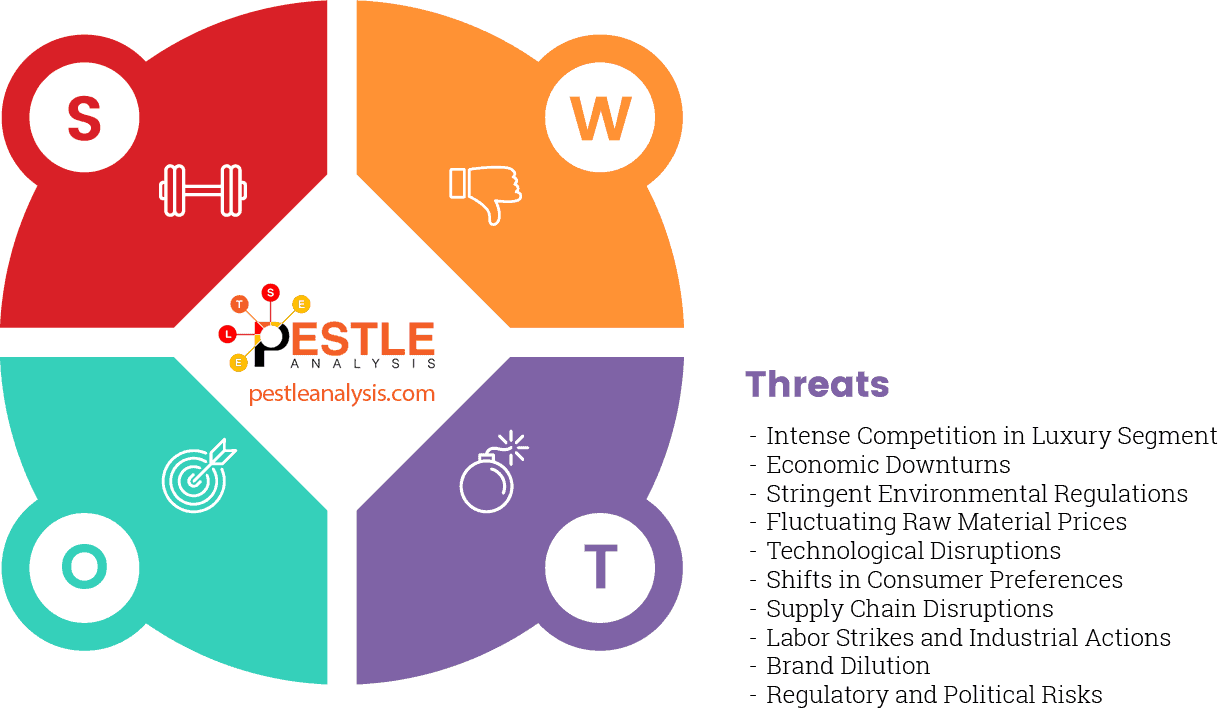
What? There are things that are threatening for THE Mercedes-Benz? Apparently so. Read on ahead to find out.
- Intense Competition in Luxury Segment: Despite being a globally recognized and extremely well-selling brand, Mercedes still has many competitors in the industry who are equally as dominant, if not more. The luxury automotive market is highly competitive, with strong rivals such as BMW, Audi, Lexus, and Tesla continuously innovating and offering high-quality vehicles. These competitors constantly keep Mercedes on its wheels. Get it? I said wheels instead of feet because they make cars. This intense competition can lead to market share erosion, price wars, and pressure on profit margins, as Mercedes-Benz must constantly innovate and differentiate its offerings to stay ahead. This makes it harder for the brand to gain more share of the market because the automobile industry is very dense. If I ask you to think of the top 5 most luxurious car brands, you will easily find four others to fit the slots after Mercedes or even all 5 instead. This is because there are a number of car brands that offer the same prestige, luxury, status symbols, and more. If not taken into account, very soon another brand can take their place. So it is very important that they not get bold and work on active strategies to stay above their competitors.
- Economic Downturns: Economic recessions, whether global or regional, can significantly reduce consumer spending on luxury goods, including high-end vehicles. During such downturns, Mercedes-Benz may experience a sharp decline in sales and revenue, which could lead to financial instability and necessitate cost-cutting measures to sustain operations.
- The automobile industry got very severely impacted after the Covid-19 pandemic hit the world because it all went into lockdown mode and people seldom needed to travel. People did not buy as many cars as the years prior to the pandemic so car brands had very slow business during this time.
- Stringent Environmental Regulations: Increasingly stringent environmental laws and emissions standards worldwide pose a significant challenge. Compliance with these regulations requires substantial investment in cleaner technologies and may result in high costs and potential fines, straining Mercedes-Benz's financial and operational resources.
- In 2020, the parent company of the brand, Daimler came under some serious fire when it was observed that they had installed certain software in their cars that can cheat on air pollution tests. 250,000 units of Mercedes-Benz had this issue for which the company had to pay a total of 1.5 billion USD to the US government who made the claims. It takes a few or sometimes even one of such scandals resulting in lawsuits to completely tarnish the reputation of even the biggest brands.
- Fluctuating Raw Material Prices: Volatility in the prices of raw materials such as steel, aluminum, and rare earth elements can lead to increased production costs. Mercedes-Benz may face the dilemma of either raising vehicle prices, which could affect demand, or absorbing the costs, which would reduce profit margins.
- Technological Disruptions and Cybersecurity Risks: Rapid advancements in technology and the growing risk of cyber attacks on connected and autonomous vehicles present substantial threats. Falling behind in innovation could render Mercedes-Benz less competitive, while cybersecurity breaches could lead to significant financial losses and erosion of consumer trust.
- Shifts in Consumer Preferences: Changes in consumer preferences towards sustainable and electric vehicles or new mobility solutions like ride-sharing can affect demand for traditional internal combustion engine vehicles. If Mercedes-Benz fails to quickly adapt to these shifts, it risks losing market relevance and customer base.
- Supply Chain Disruptions: Global supply chain disruptions caused by geopolitical tensions, natural disasters, or pandemics can lead to production delays and increased costs. These disruptions may result in an inability to meet market demand, causing lost sales and customer dissatisfaction, which can harm the brand's reputation.
- Labor Strikes and Industrial Actions: Labor disputes and strikes at manufacturing plants or within the supply chain can halt production and delay deliveries. Such actions lead to increased operational costs and necessitate negotiations or temporary hires, disrupting the smooth functioning of Mercedes-Benz’s production and delivery processes.
- Brand Dilution: Over-expansion or entering lower-end market segments may dilute Mercedes-Benz's luxury image. Such moves can erode the brand's exclusivity and prestige, potentially alienating core high-end customers and damaging the long-term reputation of the brand.
- Regulatory and Political Risks: Political instability, trade wars, and changes in trade policies or tariffs can disrupt key markets. These regulatory and political risks can lead to increased operational costs, reduced market access, and retaliatory measures that negatively impact sales and profitability, challenging Mercedes-Benz's global operations.
Learn about our full list of threats that can impact any business's stability here.
Recommendations based on this Mercedes-Benz SWOT Analysis
More research with PESTLE analysis
If you have chosen to stick by and have now reached the very end of the article, I am going to make the assumption that you enjoyed reading it!
Hopefully, you now understand the exact position of Mercedes in today’s world especially in terms of some of the important internal and external factors which affect it, that go hand in hand with other external factors demonstrated in our Mercedes-Benz PESTLE analysis.
Despite being in a bit of a pickle, they have many positives as well. Their brand equity alone solves many problems, and their money makes it possible to invest in some of the most promising activities.
Moreover, they have amazing opportunities to explore, especially the emerging market of electric vehicles. If taken timely advantage of, these can surely be converted and added to their list of strengths.
Overall, the brand Mercedes-Benz has been around for so long because they have what it takes. I don’t expect them to become a “has-been” brand anytime soon.
Continue exploring SWOT Analysis
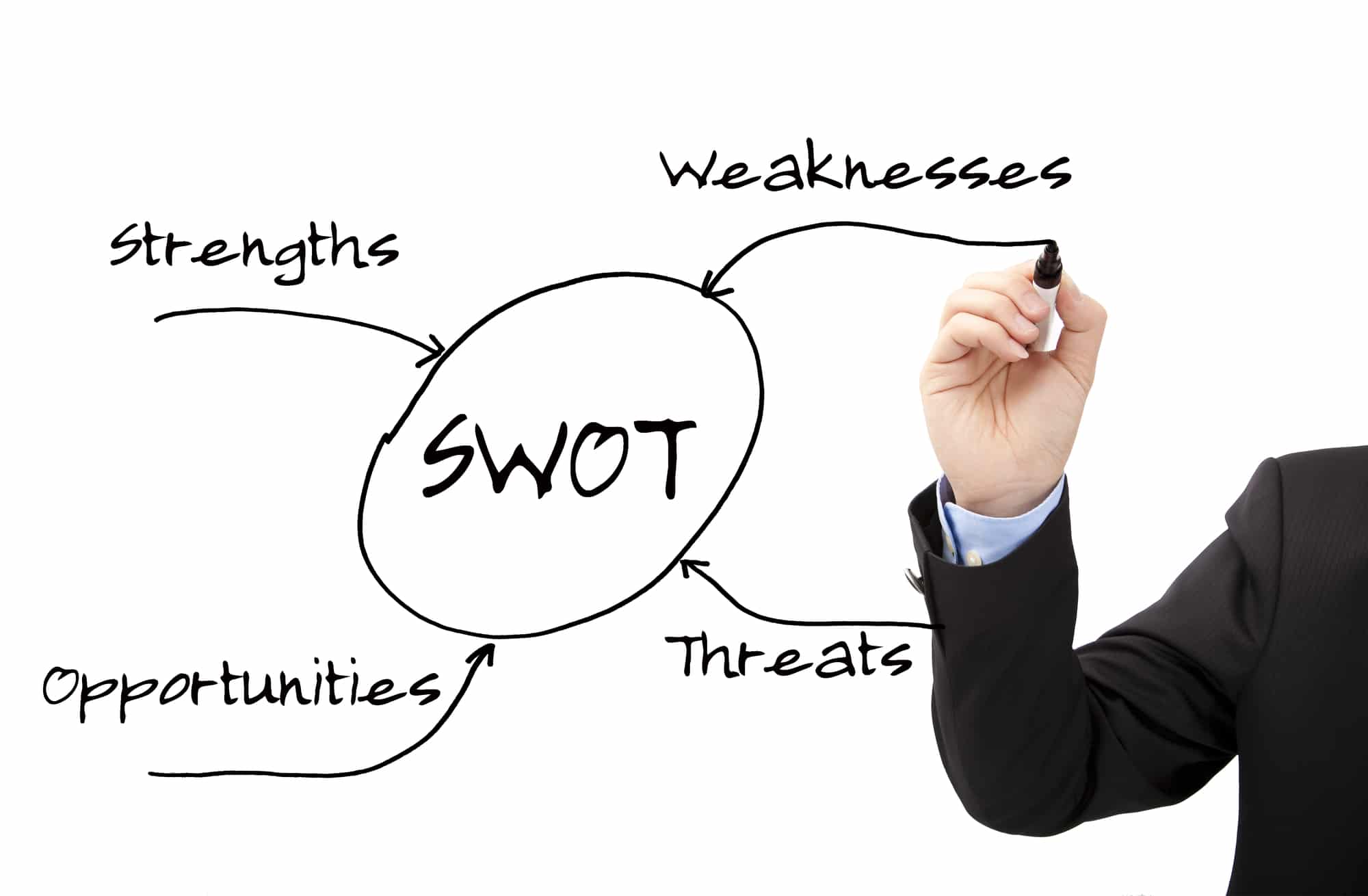
One of the easiest tools you can learn and implement to good use for better understanding a business, an industry, an organization, or even a country at large is the humble yet mighty SWOT analysis.
Not only does it accurately highlight and precisely point out the various internal (strengths and weaknesses) and external (threats and opportunities) factors of an entity for you, but it also allows you to know what and how to improve.
This is why we recommend that everyone should be aware of the mechanisms of a SWOT analysis. it does not matter if you aren’t a business owner, you still might be a student or someone working for a business both positions of which would need you to be aware of this knowledge.
Don’t be scared if you have not worked on a SWOT before, you can easily start by using a nice template to help bring your hand to practice. However, if you feel like you have enough knowledge to take on one of your own, go for it! Another way to learn is to have a look at a few more examples, particularly of Mercedes competitors:
- SWOT Analysis of BMW
- SWOT Analysis of Toyota
- SWOT Analysis of Volkswagen
- SWOT Analysis of Chevrolet
- SWOT Analysis of Ford
- SWOT Analysis of Tesla

